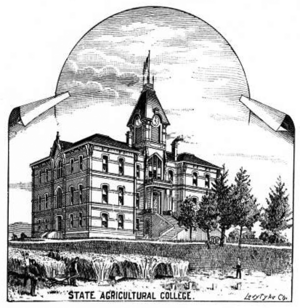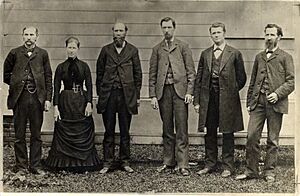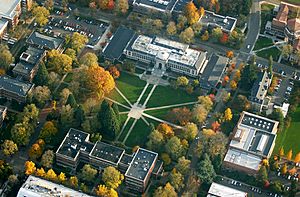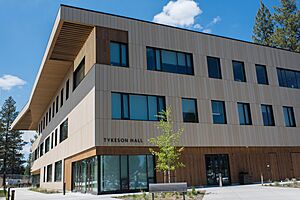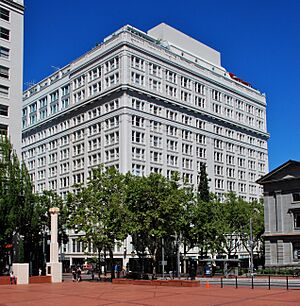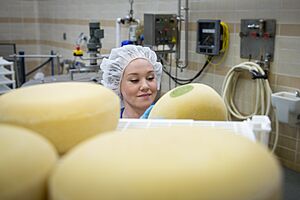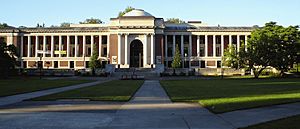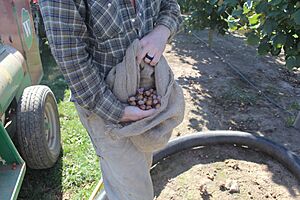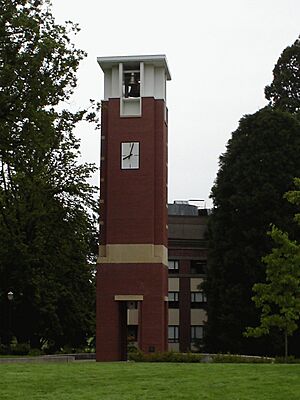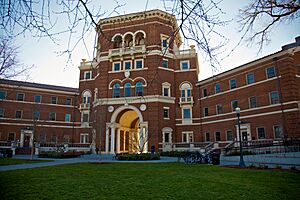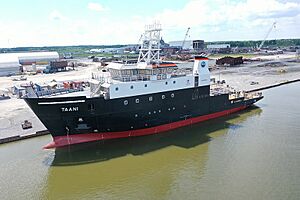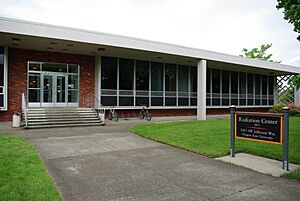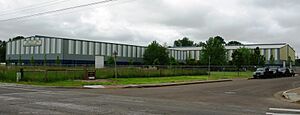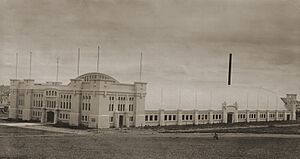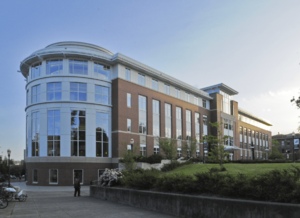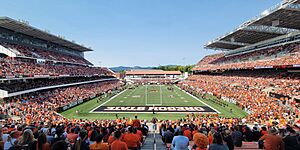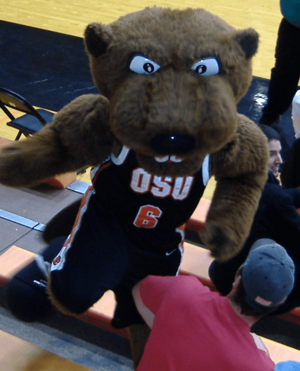Oregon State University facts for kids
 |
|
|
Former name
|
See list |
|---|---|
| Motto | "Out there" |
| Type | Public land-grant research university |
| Established | October 27, 1868 (official designated charter day) |
| Accreditation | NWCCU |
|
Academic affiliations
|
|
| Endowment | $829.9 million (2023) |
| Budget | $1.84 billion |
| President | Jayathi Murthy |
| Provost | Edward Feser |
|
Total staff
|
4,700 (spring 2023) |
| Students | 37,121 (spring 2023) |
| Undergraduates | 32,014 (spring 2023) |
| Postgraduates | 4,439 (spring 2023) |
| 1,458 (spring 2023) | |
| Location |
,
,
United States
44°33′50″N 123°16′29″W / 44.5639°N 123.2747°W |
| Campus | Small city, 420 acres (170 ha) |
| Other campuses | |
| Newspaper | The Daily Barometer |
| Colors | Orange and black |
| Nickname | Beavers |
|
Sporting affiliations
|
|
| Mascot | Benny Beaver |
 |
|
|
|
|
Oregon State University (OSU) is a large public university in Corvallis, Oregon, USA. It's a special kind of university called a land-grant and research university. This means it gets support from the government to teach practical subjects and do lots of research.
OSU offers over 200 different study programs for students getting their first college degree. It also has many programs for students who want to continue their studies after that. In 2023, over 37,000 students were learning at OSU, making it the biggest university in Oregon.
OSU is known for its amazing research. It's one of only a few schools in the country that are "land-grant," "sea-grant," "space-grant," and "sun-grant" universities. This means it does important research in areas like agriculture, ocean studies, space, and renewable energy. OSU has been the top university in Oregon for research funding for over 50 years!
Contents
Discovering OSU's Past
How OSU Began
Oregon State University started way back in 1856 as a small school called Corvallis Academy. It was a community school that taught younger students and prepared them for college. Local Freemasons helped create the school. Many buildings on campus today are named after these early founders.
The academy was one of the first places in the Oregon Territory to offer public education after high school. In 1865, William A. Finley became president and added more advanced classes. This made the school very popular for young adults in the Northwest who wanted to learn a profession.
Becoming a Public College
On August 22, 1868, the school officially became Corvallis College. The Oregon Legislative Assembly chose it to be Oregon's special "land-grant" university. This meant it would focus on agriculture and practical sciences. On October 27, 1868, OSU officially became the state's first public college.
Over the years, the school's name changed several times. This was common for land-grant colleges back then. It helped them get important government money for agricultural research. The Morrill Land-Grant Acts were laws that gave money to these colleges, helping them grow and succeed.
| Year | Name |
|---|---|
| 1868 | Corvallis College |
| 1872 | Corvallis State Agricultural College |
| 1876 | State Agricultural College |
| 1881 | Corvallis Agricultural College |
| 1882 | Corvallis College |
| 1886 | State Agricultural College of Oregon |
| 1889 | Oregon Agricultural College |
| 1927 | Oregon State Agricultural College |
| 1937 | Oregon State College |
| 1961 | Oregon State University |
By 1870, the first students earned their degrees. The school's focus shifted more towards science and technology around 1900.
Changes in the 1900s
In 1914, leaders decided to give specific study areas to OSU and the University of Oregon. This meant OSU would focus on engineering and business, while the University of Oregon would focus on liberal arts. This helped each school specialize.
The school's name changed to Oregon State Agricultural College in 1927. Then, in 1937, because it offered so many different degrees, it became Oregon State College. Finally, on March 6, 1961, it officially became Oregon State University.
Exploring OSU Campuses
Main Campus in Corvallis
The main campus in Corvallis, Oregon, is about 420 acres and is full of trees. It's like a beautiful park and is recognized as an arboretum. The campus was designed by a famous landscape architect, John Charles Olmsted, in 1906. In 2008, his design was named a historic district, making it the only college campus in Oregon with this special title.
The Memorial Union building is a stunning example of old-style architecture. It was designed by an OSU graduate.
OSU-Cascades in Bend
In 2016, OSU opened a branch campus in Bend. This campus, called OSU-Cascades, helps students in central Oregon attend classes closer to home. By 2023, the campus had grown to 30 acres and aimed to have around 5,000 students in the next ten years.
Online Learning: Ecampus
Oregon State offers over 80 degree and certificate programs online through its Ecampus. Students can take more than 1,500 online courses. U.S. News & World Report ranked OSU's Ecampus fourth nationally in 2024. The same professors who teach on campus also teach many of the online courses. Students who study online get the same diploma as those who attend in person.
OSU Portland Center
In 2017, OSU moved its Portland offices to the historic Meier & Frank building downtown. This center has modern offices, classrooms, and meeting spaces. It's a central spot for OSU in Oregon's biggest city.
The Portland Center is used for teaching, research, and connecting with the community. University experts use the space for talks and international meetings.
Hatfield Marine Science Center

The Hatfield Marine Science Center in Newport, Oregon, is one of the best marine laboratories in the country. It has been there for over 50 years. It's a base for ocean research for many state and federal groups. It also helps teachers and the public learn about the ocean.
Students studying agriculture, oceanography, and marine science can intern here. Graduate students work on many research projects all year. In 2023, a new dormitory was approved for graduate students and staff near the Newport campus.
Food Innovation Center
OSU's College of Agriculture runs the Food Innovation Center (FIC) in Portland. This center helps food companies in Oregon create new food products and make them successful. Researchers at the center help with developing products, food safety, packaging, and marketing.
The FIC was the first urban agricultural research station in the country. It's a special place that helps Oregon's big $5 billion agriculture industry.
How OSU is Organized
Colleges and Departments
OSU uses a "quarter-system" for its classes, which means there are four 11-week terms each year. The university has 11 main colleges, an honors college, and a graduate school. Each college has a leader called a dean. These colleges are then divided into smaller schools or departments.
- College of Agricultural Sciences
- College of Business
- College of Earth, Ocean, and Atmospheric Sciences
- College of Education
- College of Engineering
- College of Forestry
- College of Liberal Arts
- College of Pharmacy
- College of Public Health and Human Sciences
- College of Science
- Carlson College of Veterinary Medicine
- University Honors College
OSU Extension Service
The OSU Extension Service helps people who are not regular students, especially adults. It was started in 1911. There are OSU Extension offices and research stations all over Oregon.
They have programs like 4-H for young people, help for farmers, and classes on healthy eating. They also teach about Forestry and natural resources.
How OSU Gets Money
The Oregon State University Foundation helps raise money for the university. In 2007, they started a big fundraising campaign to raise $625 million. They reached that goal early and kept going, eventually raising over $1.1 billion by the end of 2014! This made OSU one of only a few public universities to raise over a billion dollars.
In October 2022, the Foundation started another big fundraising campaign called "Believe It: The Campaign for OSU." Their goal is to raise $1.75 billion to support students, professors, buildings, and new projects. By 2025, they had already received over $1 billion in gifts for this campaign.
Global Connections
Oregon State has many partnerships with universities around the world. These include schools in Australia, Bulgaria, New Zealand, and India.
Learning and Research at OSU
Getting into OSU
U.S. News & World Report says that getting into Oregon State is "selective." OSU is the biggest university in Oregon. In 2023, it had a record number of students, nearly 37,000.
In Fall 2022, OSU welcomed its largest group of new students ever, with 7,146 freshmen.
Amazing Research
Research is a huge part of what OSU does. Most of the research happens at the Corvallis campus, but many projects are also done across Oregon and even in other countries. Some research places include the Aquatic Animal Health Laboratory and the Food Innovation Center.
OSU is known for its "very high research activity." It's the only university in Oregon with this special classification. OSU was also one of the first schools to be part of the federal Space Grant program in 1991. This made it one of only 13 schools at the time to be a Land Grant, Sea Grant, and Space Grant university all at once.
OSU researchers have helped improve crops like wheat and hops in Oregon. The famous Cascade hop, used in many craft beers, was created at OSU.

The College of Earth, Ocean and Atmospheric Sciences (CEOAS) at OSU runs several labs, including the Hatfield Marine Science Center. They also operate ocean research ships based in Newport, Oregon. CEOAS is leading the biggest ocean science project in U.S. history, called the Ocean Observatories Initiative. This project uses underwater robots to study the oceans.
CEOAS is also designing and building new ocean research ships for the National Science Foundation. The first of these ships, the Taani, was launched in May 2023 and is based in Newport.
OSU also manages over 11,250 acres of forest land for research. The Radiation Center on campus has a nuclear reactor used for research. In the early 2000s, researchers there developed the first working model of a Small Modular Reactor (SMR). These are small nuclear reactors that can power buildings and factories.
The O. H. Hinsdale Wave Research Laboratory at OSU is one of the largest labs in the world for studying waves and coastal areas. It's used for research and testing related to tsunamis.
OSU also has two offshore test sites near Newport for companies to test new wave energy technology.
Military Programs
Oregon State University is one of the few universities that has ROTC (Reserve Officers' Training Corps) programs for all branches of the US Military. The Army ROTC program started in 1873. It's known for training many officers during World War II.
After World War II, a Naval Science department was added for training officers for the US Navy and US Marine Corps. In 1949, the Air Force ROTC program also started. In 1977, two women who graduated from OSU's Air Force ROTC became the first women pilots in the Air Force.
The Valley Library
In 1999, OSU finished a big $40 million renovation of its main library. This library, called the Valley Library, was named "Library of the Year" in 1999.
The Valley Library is also home to the Oregon Hops and Brewing Archives. This is the first archive in the U.S. dedicated to collecting the history of hops and brewing in the Pacific Northwest. It has old papers, photos, and records about how hops are grown and how beer is made.
Rankings and Achievements
In 2023, the Center for World University Rankings placed Oregon State University in the top 1.4 percent of all universities worldwide. This means it's one of the best schools out of over 20,000!
U.S. News & World Report ranked OSU tied for 139th nationally in 2021. Its online Ecampus program has been in the top 10 nationally since 2015.
In 2021, the Academic Ranking of World Universities ranked OSU's oceanography program 5th in the world. Its agricultural sciences program was in the top 50 worldwide.
Student Life at OSU
Corvallis is a smaller city, and many local events are connected to the university. OSU has over 400 student clubs and groups. The campus is also close to many outdoor activities like forests, the coast, and rivers. Portland, Oregon's largest city, is about 85 miles north of campus.
Most older students live off campus, but new freshmen usually live in one of the 16 residence halls on campus.
The The LaSells Stewart Center is where many conferences and performances happen on campus. Famous speakers have visited, and the Corvallis-OSU Symphony often plays there.
The PRAx (Patricia Valian Reser Center for the Creative Arts) is a new arts center at OSU. It has a concert hall, a theater, an art gallery, and outdoor spaces for events.
OSU also has Orange Media Network, which is run by students. It includes the student newspaper The Daily Barometer, a radio station (KBVR 88.7 FM), a TV station (KBVR-TV), and student magazines.
Student Government
The Associated Students of Oregon State University (ASOSU) is the official student government. They represent all students on campus and speak for them on important issues.
Diversity at OSU
| Race and ethnicity | Total | ||
|---|---|---|---|
| White | 64% |
|
|
| Hispanic | 13% |
|
|
| Asian | 8% |
|
|
| Two or more races | 7% |
|
|
| International student | 3% |
|
|
| Black | 2% |
|
|
| Unknown | 2% |
|
|
| American Indian/Alaska Native | 1% |
|
|
| Economic diversity | |||
| Low-income | 23% |
|
|
| Affluent | 77% |
|
|
OSU works hard to have a diverse group of students and staff. In 2022, 30 percent of all students at Oregon State University were students of color.
The university has several cultural centers to support students from different backgrounds. These include the Lonnie B. Harris Black Cultural Center, Native American Longhouse, Asian & Pacific Cultural Center, and the Centro Cultural César Chávez. There's also a Pride Center for LGBTQ+ students.
OSU Sports and Teams
In 2008, STACK ranked Oregon State as one of America's "premier" universities for academics, sports, and overall performance.
The history of OSU sports goes back to 1893. The official mascot became the beaver in 1910, and it's still the mascot today! In 1915, OSU's sports teams joined the Pacific Coast (Athletic) Conference.
Reser Stadium is where the school's football team plays. The mascot, Benny the Beaver, first appeared at football games in 1952. In 1962, Terry Baker, an OSU quarterback, won the Heisman Trophy, a huge award in college football. The University of Oregon is OSU's big rival in sports. Their annual football game is one of the longest-running rivalries in college football.
The university's home golf course is called Trysting Tree's. Basketball games are held in Gill Coliseum, named after a former coach. The Coliseum is also home to the wrestling team. Baseball is played at Goss Stadium at Coleman Field. The OSU baseball team won the NCAA Division I Baseball Championship in 2006, 2007, and 2018! Softball is played at the OSU Softball Complex.
Oregon State has won four NCAA championships. Besides the three baseball titles, the Beavers won the 1961 NCAA Men's Cross Country Championship. The men's rowing team also won a national championship in 1975. The Oregon State racquetball team has won 10 national championships in a row since 2008.
Famous People from OSU
Notable Faculty and Staff
OSU has had many famous professors and staff, including:
- Bernard Malamud, a well-known writer.
- George Poinar Jr., a professor whose work with insects in amber helped inspire the Jurassic Park book and movie.
- Ernest H. Wiegand, who invented the modern Maraschino cherry.
- Pat Casey, the baseball coach who led the team to three national championships.
- Slats Gill and Ralph Miller, famous basketball coaches who are in the Hall of Fame.
- James Cassidy, a soil scientist who is also a musician in the band Information Society.
- Craig Robinson, a former basketball coach and brother-in-law of President Barack Obama.
Famous Alumni
Oregon State University has over 200,000 graduates who have done amazing things. One of the most famous is Linus Pauling, a scientist and peace activist. He is the only person to win two Nobel Prizes by himself, one for chemistry and one for peace! Another very famous graduate is Jensen Huang, who founded the company Nvidia.
Many OSU athletes have also become professional sports stars in baseball, basketball, and football.
Places to See at OSU

- Hatfield Marine Science Center
- Linus Pauling Institute
- O. H. Hinsdale Wave Research Laboratory
- Oregon State University Cascades Campus
- Oregon State University Radiation Center
- Peavy Arboretum
Images for kids
See also
 In Spanish: Universidad Estatal de Oregón para niños
In Spanish: Universidad Estatal de Oregón para niños


